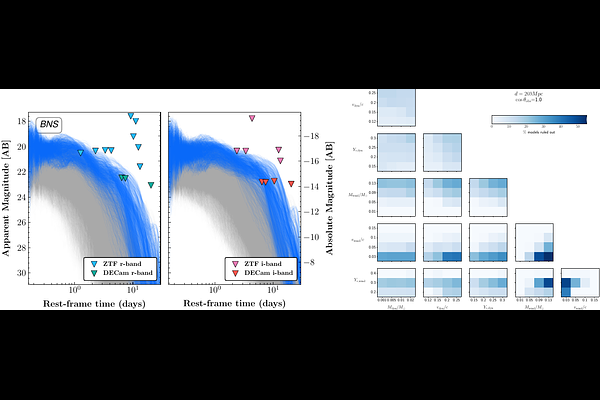LIGO/Virgo/KAGRA neutron star merger candidate S250206dm: Zwicky Transient Facility observations

LIGO/Virgo/KAGRA neutron star merger candidate S250206dm: Zwicky Transient Facility observations
Tomás Ahumada, Shreya Anand, Mattia Bulla, Vaidehi Gupta, Mansi Kasliwal, Robert Stein, Viraj Karambelkar, Eric C. Bellm, Theophile Jegou du Laz, Michael W. Coughlin, Igor Andreoni, Smaranika Banerjee, Aleksandra Bochenek, K-Ryan Hinds, Lei Hu, Antonella Palmese, Daniel Perley, Natalya Pletskova, Anirudh Salgundi, Avinash Singh, Jesper Sollerman, Vishwajeet Swain, Avery Wold, Varun Bhalerao, S. Bradley Cenko, David O. Cook, Chris Copperwheat, Matthew Graham, David L. Kaplan, Leo P. Singer, Niharika Sravan, Malte Busmann, Julius Gassert, Daniel Gruen, Julian Sommer, Yajie Zhang, Ariel Amsellem, Tomás Cabrera, Xander J. Hall, Keerthi Kunnumkai, Brendan O'Connor, Tyler Barna, Felipe Fontinele Nunes, Andrew Toivonen, Argyro Sasli, Frank J. Masci, Tracy X. Chen, Richard Dekany, Josiah Purdum, Antoine Le-Calloch, G. C. Anupama, Sudhanshu Barway
AbstractWe present the searches conducted with the Zwicky Transient Facility (ZTF) in response to S250206dm, a bona fide event with a false alarm rate of one in 25 years, detected by the International Gravitational Wave Network (IGWN). Although the event is significant, the nature of the compact objects involved remains unclear, with at least one likely neutron star. ZTF covered 68% of the localization region, though we did not identify any likely optical counterpart. We describe the ZTF strategy, potential candidates, and the observations that helped rule out candidates, including sources circulated by other collaborations. Similar to Ahumada et al. 2024, we perform a frequentist analysis, using simsurvey, as well as Bayesian analysis, using nimbus, to quantify the efficiency of our searches. We find that, given the nominal distance to this event of 373$\pm$104 Mpc, our efficiencies are above 10% for KNe brighter than $-17.5$ absolute magnitude. Assuming the optical counterpart known as kilonova (KN) lies within the ZTF footprint, our limits constrain the brightest end of the KN parameter space. Through dedicated radiative transfer simulations of KNe from binary neutron star (BNS) and black hole-neutron star (BHNS) mergers, we exclude parts of the BNS KN parameter space. Up to 35% of the models with high wind ejecta mass ($M_{\rm wind} \approx 0.13$ M$_{\odot}$) are ruled out when viewed face-on ($\cos\theta_{\rm obs} = 1.0$). Finally, we present a joint analysis using the combined coverage from ZTF and the Gravitational Wave Multimessenger Dark Energy Camera Survey (GW-MMADS). The joint observations cover 73% of the localization region, and the combined efficiency has a stronger impact on rising and slowly fading models, allowing us to rule out 55% of the high-mass KN models viewed face-on.